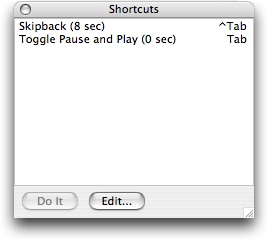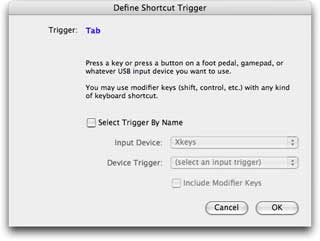4.1 Shortcuts
Keyboard shortcuts are an important aspect of InqScribe. They can greatly ease the transcription process, and allow you to create customized actions that go beyond what the remote control buttons provide.
4.1.1 Activating Shortcuts
When InqScribe launches, keyboard shortcuts are turned on by default. If you need to turn shortcuts off, you can use the Edit > Enable Shortcuts menu item.
4.1.2 Managing Shortcuts
InqScribe's default settings include two shortcuts.
- The tab key toggles between play and pause.
- Control-tab skips back 8 seconds.
You can change these shortcuts, remove them, or add your own shortcuts via the Edit Shortcuts and Snippets dialog. To open this dialog, select the Edit > Edit Shortcuts... menu item (or click Edit... in the floating window).
- Use the Add button to create a new shortcut.
- Use the Edit button to edit an existing shortcut.
- Use the Remove button to remove an existing shortcut. You can hold down the alt key (option key on Mac) to skip the confirmation dialog.
- Use the Reset to Defaults button to reset the shortcuts (and snippets) to InqScribe's default settings.
4.1.3 Editing a Shortcut
When you select a shortcut in the dialog, the right hand side of the window updates to show the shortcut's current properties.
Name
InqScribe generates names for shortcuts automatically. But you can enter your own name for a shortcut if you prefer. (Note that shortcuts are always sorted alphabetically.)
Trigger
The trigger is the key combination (F5, control-shift-P, etc.) you set that will activate the shortcut. Click the Define Trigger button to define the trigger for a shortcut. Click the Clear Trigger button if you want to remove the trigger from the shortcut.
When you click Define Trigger, this dialog appears.
Press a key combination to set the trigger for your shortcut. You can also use USB input devices like foot pedals or gamepads. Just press the button or pedal on the device to set the trigger.
When you've defined a trigger, click the OK button. (Note that you can't use the keyboard to click OK; InqScribe might think you're trying to define a trigger.)
There are some limitations on the kinds of keyboard combinations you can use as shortcuts. Those limits are described here.
Windows Trigger Limitations
- Existing system-wide hotkeys (e.g. print screen) may not be used.
- Avoid key combinations that are already mapped to menu items, like control-; or control-O. Such combinations will trigger both the menu item and the shortcut, which probably isn't what you want.
Mac OS Trigger Limitations
- Existing system-wide hotkeys (e.g. Exposé) may not be used.
- Be careful using F1-F4. On some Macs, these keys are automatically mapped to Undo, Cut, Copy, and Paste.
- Avoid key combinations that are already mapped to menu items, like command-; or command-O. Such combinations will trigger both the menu item and the shortcut, which probably isn't what you want.
- Avoid key combinations that are used to enter accented characters (for example, option-u, option-e, option-a). These combinations are handled by the OS in a special way, and while InqScribe can detect them, InqScribe cannot prevent them from also being typed into your transcript.
Action
You can choose the action you want to associate with the shortcut from the popup menu. A full list of actions is shown below.
Some actions take additional parameters. Additional controls will appear if needed to allow you to set those parameters as well. For example, the Set Volume action lets you choose a value to set the volume to. See the list of possible actions for more information about what this value means for different actions.
4.1.4 Available Shortcut Actions
This list catalogs all available actions in the order they appear in the popup menu.
Toggle Pause and Play
Alternates between pausing the movie and playing it again.
Skip Back
Skips the media file back in time without changing its state. (So if the file was already playing, it will continue to play.) This action is useful during transcription because it lets you quickly and easily repeat passages.
Use the Skip value field to set the number of skip back seconds.
Note: You can combine the behavior of both the Toggle and Skip Back actions into a single action called, not surprisingly, Skip Back/Toggle Combination. The combination action is very useful if you have only one key shortcut easily available (e.g. a USB foot pedal, or you'd like to always use the tab key without having to hold down a modifier key).
Skip Forward
Skip forward as many seconds as you define without changing the current state. This is usfeul to skip past content while trying to find something specific.
Stop
Stops the video. Currently equivalent to Pause.
Pause
Pauses the video. Currently equivalent to Stop.
Insert Current Time
Inserts the current time into the transcript. Identical to the Edit > Insert Time menu item.
This command does not work when InqScribe is in the background.
Play
Plays the movie at normal speed.
Play until Released
Plays the media at a speed you choose until the shortcut is released.
Play at Custom Rate
Plays the media at a speed you choose.
Play Backwards
Plays the movie backwards at normal speed.
Play Backwards at Custom Rate
Plays the media backwards at a speed you choose.
Cue
Plays the movie forward at a speed you choose, for as long as the shortcut is held down.
Review
Plays the movie backwards at a speed you choose, for as long as the shortcut is held down.
Fast Forward
Plays the movie forward at high speed.
Rewind
Plays the movie backwards at high speed.
Advance One Frame
Advances the movie a single frame.
Rewind One Frame
Rewinds the movie a single frame.
Play Forward at Custom Rate
Plays the movie forward at a speed you specify.
Use the action value to set the speed as a percentage of normal (100). So to play back at 2x, enter "200". To play back at half speed, enter "50".
Play Backwards at Custom Rate
Plays the movie backwards at a speed you specify.
Use the action value to set the speed as a percentage of normal (100). So to play back at 2x, enter "200". To play back at half speed, enter "50".
Jump to End
Jumps to the end of the movie and stops playback.
Jump to Beginning
Jumps to the start of the movie and stops playback.
Go To Next Timecode
Jumps to the next timecode in your transcript, where "next" means the earliest timecode in the transcript that is later than the current time. If there are no later timecodes, InqScribe will beep.
This command does not work when InqScribe is in the background.
Go To Previous Timecode
Jumps to the next timecode in your transcript, where "previous" means the latest timecode in the trnascript that is earlier than the current time. If there are no earlier timecodes, InqScribe will beep.
This command does not work when InqScribe is in the background.
Select Next Timecode
Select the next timecode in your transcript, where "next" means the first timecode InqScribe finds after the currently selected text (or cursor location if no text is selected). InqScribe will also jump to this point in the media. If no timecode is found, InqScribe will beep.
This command does not work when InqScribe is in the background.
Select Previous Timecode
Select the previous timecode in your transcript, where "previous" means the first timecode InqScribe finds before the currently selected text (or cursor location if no text is selected). InqScribe will also jump to this point in the media. If no timecode is found, InqScribe will beep.
This command does not work when InqScribe is in the background.
Change Play Rate
Changes the play rate by the amount you specify.
Use the action value to set the amount of change as a percentage of normal (100). To change the rate by 10%, enter "10". To change the rate by 20%, enter "20". Enter a negative number to slow down the play rate by a given amount.
For example, if the current play rate is 1.0x and you change the play rate by 20%, the new play rate is 1.2x.
Set Play Rate
Changes the play rate to the speed you specify. The speed may be positive or negative.
Use the action value to set the new speed as a percentage of normal (100).
Change Volume
Changes the volume by the amount you specify.
Use the action value to set the amount of change as a percentage (100% = maximum volume). To change the rate by 10%, enter "10". To change the rate by 20%, enter "20". Enter a negative number to reduce the volume by a given amount.
For example, if the current volume of 50% and you change the volume by 10%, the new volume is 60%.
Mute
Toggles between muted and unmuted state.
Set Volume
Changes the volume an absolute level you specify.
Use the action value to set the volume as a percentage (100% = maximum volume).
Set Display Size
Change the size of the video to a new size you specify.
Use the action value to set the new size as a percentage (100% = normal).
Skip Back/Toggle Combination
Most users are comfortable with two separate keys for Toggle and Skip Back, which are often the two most frequently used shortcuts during transcription. However, for cases where you want to map both actions to the same key (perhaps you're using a USB foot pedal with only one button), use this action.
This action combines the effects of Toggle Pause and Play and Skip Back in the following way:
- The first time you press the action key, it acts like Toggle Pause and Play.
- If you press the action key again within a set period of time, it acts like Skip Back, and undoes the effect of the Toggle Pause and Play action.
- If you continue to press the action key within a set period of time, each addition press triggers an additional Skip Back.
- Once the set period of time has passed from the initial key press, everything resets, so the next time you press the key, it will act as Toggle again.
The set period of time is roughly half a second or so -- similar to the amount of time that separates two single clicks of the mouse from one double-click.
Here's an example to make this concrete. Imagine your movie is playing, and you realize you want to jump back several seconds. You hit the action key three times in succession. Here's what happens:
- After the first key, the movie pauses.
- After the second key, the movie skips back N seconds and resumes playing.
- After the third key, the movie skips back another N seconds and resumes playing.
The action value for this action is similar to that of Skip Back: it controls how many seconds to skip back with each action.
Insert Snippet
Similar to the Edit > Insert Snippet menu item. Displays the Snippets window so you may easily select a snippet to enter into the transcript.
This command does not work when InqScribe is in the background.



